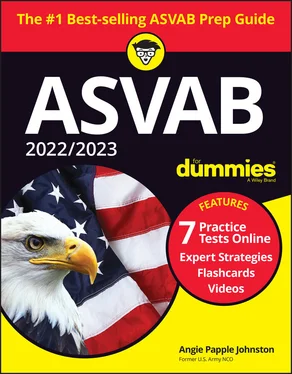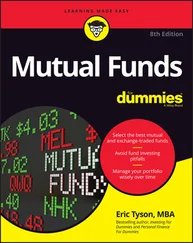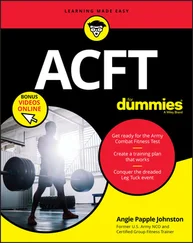When You Don’t Know an Answer: Guessing Smart
On the ASVAB, guessing is sometimes okay. Guessing can help you on the paper-and-pencil version because of how the test is scored. Here’s how the point system breaks down:
If you choose the correct answer, you get one point (or more, depending on how the question is weighted).
If you don’t answer a question, you get nada.
If you guess on a question and get the question wrong, you get nada — no worrying about losing points or getting any sort of penalty!
 Don’t make wild guesses if you can make educated guesses. However, if you’re nearing the end of a subtest on the CAT-ASVAB and you know you won’t have time to finish, try to select answers for every question. If you fail to complete a subtest, you’ll be penalized; the system will score the items you didn’t complete as though you answered them randomly.
Don’t make wild guesses if you can make educated guesses. However, if you’re nearing the end of a subtest on the CAT-ASVAB and you know you won’t have time to finish, try to select answers for every question. If you fail to complete a subtest, you’ll be penalized; the system will score the items you didn’t complete as though you answered them randomly.
The ASVAB’s computer system rarely has to penalize a test-taker. On average, the computerized test takes about two hours to complete, and most people have enough time to finish (or at least come very close to finishing) the test.
 Because ASVAB questions have four possible answers, you have at least a 25 percent chance of guessing correctly, which means you have chances to increase your score. There’s nearly always at least one answer that isn’t even close to the correct answer, so by using simple deduction, you can often narrow your choices down to three answers or fewer. Here are some things to keep in mind when eliminating answer choices:
Because ASVAB questions have four possible answers, you have at least a 25 percent chance of guessing correctly, which means you have chances to increase your score. There’s nearly always at least one answer that isn’t even close to the correct answer, so by using simple deduction, you can often narrow your choices down to three answers or fewer. Here are some things to keep in mind when eliminating answer choices:
Don’t eliminate an answer based on how frequently that answer comes up. For example, if Choice (B) has been the correct answer for the last five questions, don’t assume that it must be the wrong answer for the question you’re on just because that would make it six in a row.
An answer that has always, all, everyone, never, none, or no one is usually incorrect.
The longer the answer, the more likely that it’s the correct answer. The test-makers have to get all those qualifiers in there so you can’t find an example to contradict the correct answer. If you see phrases like “in many cases” or “frequently,” that’s often a clue that the test-makers are trying to make the answer most correct.
If two choices are very similar in meaning, neither of them is probably the correct choice. On the other hand, if two answer options contradict each other, one of them is usually correct.
 If you have to guess, never, ever go back and change the answer, unless you’re absolutely, 100 percent, positively convinced that you’re changing it to the correct answer and you answered incorrectly only because you had sweat in your eyes and didn’t read the choices properly. The United States Air Force Senior NCO Academy conducted an in-depth study of several Air Force multiple-choice test results, taken over several years, and found that when students changed answers on their answer sheets, they changed from a right answer to a wrong answer more than 72 percent of the time!
If you have to guess, never, ever go back and change the answer, unless you’re absolutely, 100 percent, positively convinced that you’re changing it to the correct answer and you answered incorrectly only because you had sweat in your eyes and didn’t read the choices properly. The United States Air Force Senior NCO Academy conducted an in-depth study of several Air Force multiple-choice test results, taken over several years, and found that when students changed answers on their answer sheets, they changed from a right answer to a wrong answer more than 72 percent of the time!
In each of the chapters in Parts 3, 4, and 5, you find more hints for making educated guesses that are specific to those topics.
 If you guess on more than one question throughout the test, choosing the same answer for every guess is a smart way to go. For example, all your guesses could be Choice (B). This technique slightly increases your chances of getting more answers correct. However, if you can eliminate Choice (B) as a wrong answer, then, by all means, choose a different answer option for that question.
If you guess on more than one question throughout the test, choosing the same answer for every guess is a smart way to go. For example, all your guesses could be Choice (B). This technique slightly increases your chances of getting more answers correct. However, if you can eliminate Choice (B) as a wrong answer, then, by all means, choose a different answer option for that question.
Studying and Practicing for the ASVAB
The practice tests that come with this book are valuable study aids. Before you begin studying, take one of the tests. Try to duplicate the testing environment — take the entire exam at one time, time yourself, and don’t allow interruptions.
 The military has a saying, “Train as you fight.” The same is true of the ASVAB. If you’ll be taking the CAT-ASVAB, spend most of your time practicing with online tests (check out the later section “ Getting Access to the Online Test Bank” for details on unlocking the online tests that come with this book). If you plan to take the paper-and-pencil version of the ASVAB, concentrate most of your efforts on the written practice tests in this book.
The military has a saying, “Train as you fight.” The same is true of the ASVAB. If you’ll be taking the CAT-ASVAB, spend most of your time practicing with online tests (check out the later section “ Getting Access to the Online Test Bank” for details on unlocking the online tests that come with this book). If you plan to take the paper-and-pencil version of the ASVAB, concentrate most of your efforts on the written practice tests in this book.
Get a sense of how long it takes you to complete each subtest so you know how much time you have to spend on educated guessing. After you complete each practice test, check your answers to see where you need improvement.
 When you study for the ASVAB, fall in line with these study habits to make the most of your time:
When you study for the ASVAB, fall in line with these study habits to make the most of your time:
Focus on the subtests that matter to you. If you have a clear interest in pursuing a career in electronics, the Electronics Information subtest should be at the top of your list to ace. Although you’ll want to make sure all your line scores are good (in case your desired job isn’t available or you want to retrain later in your career), focusing on your expertise in certain areas of interest makes you a more desirable candidate. (See Chapter 2and Appendix Afor lists of the subtests that affect your acceptance into the job areas you’re pursuing.)
Concentrate on subject areas that need improvement. It’s human nature to find yourself spending your study time on subject areas that you have an interest in or that you’re good at. If you’re a whiz at fixing cars, don’t waste your time studying for the Auto & Shop Information subtests. You’re already going to ace that part of the test, right? On the other hand, if you had a hard time in math during your high school years, you need to spend extra time brushing up on your arithmetic skills.
Be a loner. You may want to study with a partner now and then so the two of you can brainstorm answers and quiz each other, but most of your studying should be done on your own.
Try to reduce distractions. Always study in a well-lit, quiet area away from pets, loud music, and the TV.
Study in long blocks of time. Studying for an hour or two once or twice a day is much more effective than studying 15 minutes six times a day.
Schedule your study times when you are rested. Don’t try to cram studying into your schedule. Quality over quantity!
Keep study breaks short. A few minutes every hour is sufficient. Don’t ignore breaks completely, however. Studies show that taking short breaks while you study improves how well you’re able to remember information.
Practice the actual act of test-taking. Practice marking answers correctly on the answer key and time yourself to see how long it takes you to answer questions.
 If you’re unsure of how to begin studying for the ASVAB, check out the 12-week study strategy in Appendix B. If you don’t have 12 weeks left before you take the test, you can accelerate the schedule and zero in on what’s most important.
If you’re unsure of how to begin studying for the ASVAB, check out the 12-week study strategy in Appendix B. If you don’t have 12 weeks left before you take the test, you can accelerate the schedule and zero in on what’s most important.
Читать дальше

 Don’t make wild guesses if you can make educated guesses. However, if you’re nearing the end of a subtest on the CAT-ASVAB and you know you won’t have time to finish, try to select answers for every question. If you fail to complete a subtest, you’ll be penalized; the system will score the items you didn’t complete as though you answered them randomly.
Don’t make wild guesses if you can make educated guesses. However, if you’re nearing the end of a subtest on the CAT-ASVAB and you know you won’t have time to finish, try to select answers for every question. If you fail to complete a subtest, you’ll be penalized; the system will score the items you didn’t complete as though you answered them randomly. Because ASVAB questions have four possible answers, you have at least a 25 percent chance of guessing correctly, which means you have chances to increase your score. There’s nearly always at least one answer that isn’t even close to the correct answer, so by using simple deduction, you can often narrow your choices down to three answers or fewer. Here are some things to keep in mind when eliminating answer choices:
Because ASVAB questions have four possible answers, you have at least a 25 percent chance of guessing correctly, which means you have chances to increase your score. There’s nearly always at least one answer that isn’t even close to the correct answer, so by using simple deduction, you can often narrow your choices down to three answers or fewer. Here are some things to keep in mind when eliminating answer choices:










